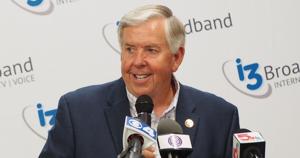Missouri plans broadband expansion with $400 million in federal COVID relief funds

(The Center Square) – The day after Missouri Gov. Mike Parson announced a $400 million broadband infrastructure plan, he emphasized no tax revenue was being awarded to a new Internet provider in St. Peters.
“They’re doing this on their own, so that frees up more resources to go to other parts of the state where they don’t have the resources,” Parson said Friday after a ribbon-cutting event at i3 Broadband, a fiber-to-home high-speed Internet provider.
The governor on Thursday used the Missouri State Fair as a backdrop to unveil a plan using hundreds of millions in American Rescue Plan Act funds to increase broadband Internet access, adoption and assistance statewide. The plan will be presented to the legislature in January for appropriation. Earlier this summer, the department of economic development applied for $56 million for broadband development from the U.S. Department of Commerce’s National Telecommunications and Information Administration.
The $1 trillion bipartisan federal infrastructure plan, passed by the Senate and now in the House, also includes $65 billion for broadband expansion.
“There’s more money coming for broadband, but this company hasn’t used any (tax) money to locate here and are not using to go into any areas where they are developing,” said Republican Congressman Blaine Luetkemeyer. “That doesn’t mean that down the road there might be areas they might use dollars.”
Parson said improving broadband is an appropriate use of federal funds for pandemic recovery.
“I think one thing we’ve learned coming out of the pandemic is how important broadband is when it comes to education of our kids and when it comes to telemedicine,” he said. “Those things are important, plus we need to be able to do business from home versus a brick-and-mortar building. I think all of that is part of the recovery effort. I think we did a really good job with the resources we had and we’re still moving forward every day.”
Leaders from three state departments – economic development, elementary and secondary education and agriculture—praised the broadband investment in the news release announcing the plan along with the Missouri Farm Bureau.
“Missouri thrives when its rural communities are strong, and Gov. Parson’s plan will help bridge the digital divide between cities and rural areas,” Missouri Farm Bureau President Garrett Hawkins said. “It will provide enormous progress toward linking all parts of our state with the modern economy, precision agriculture and telemedicine.”
Paul Cronin, the chief executive officer of i3 Broadband, praised Parson’s plan for making broadband available to underserved areas throughout the state.
“I think that’s a good way to spend federal dollars and a great example of how a public-private partnership can work,” Cronin said. “It helps to bring in companies with expertise in building and managing networks and serving customers. When you look at the economics of getting service out to farming areas and other underserved areas, this is a great way to get service to those people.”
As telecommunications companies begin rolling out 5G cellular capabilities and expanded cell phone and Internet services, Cronin said high-speed lines will continue to serve a critical need.
“5G is going to be important as far as providing services, but I don’t think it will be a replacement for a fiber-optic backbone,” Cronin said. “It’s not going to be a substitute for a rich fiber-optic network.”
House Speaker Rob Vescovo, R-Arnold, formed a special interim committee on broadband development earlier this year. Missouri ranks 32nd in the nation in broadband access with more than 147,000 unserved or underserved households and nearly 400,000 individuals without reliable internet access, according to the broadband development office in the department of economic development. About 55% of Missourians have access to a low-cost Internet plan and 23% of the state’s students lack access to high-speed Internet with most of those students living in rural areas.
“I think it’s a great analogy to look at broadband and information services in the same way we looked at bringing people electricity years ago,” Cronin said.
Disclaimer: This content is distributed by The Center Square
